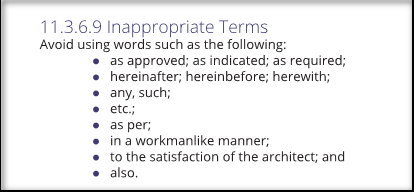Specifications must be written following the "Four C's" of effective communication: Clear, Concise, Correct and Complete. Getting each "C" done right presents its own challenges. To be correct, a spec must avoid errors and properly describe the scope of work without over or under specifying performance. To be complete, the spec must not omit any important information. Those two "C's" are challenging because they pertain to the content; they both require in-depth communication with the design team to understand the project requirements and special knowledge of building systems. The other two "C's" relate more to the specification's writing style.
Avitru, in their MasterSpec product, does a pretty good job of writing their specs using correct grammar and most of their paragraphs are written in the recommended imperative mood. They also avoid using most items from the list of "Inappropriate Terms" designated by CSI in their Project Delivery Practice Guide:

Still, there is a joke going around the Conspectus office that the MasterSpec authors must be paid by the word. If true, it would go a long way to explaining why there are so many words in the MasterSpec guides.
A grammar rule routinely ignored in MasterSpec is to limit the use of prepositional phrases. A sentence with three or more prepositional phrases will be less clear than one with fewer. That's why, despite striving to offer guides that can be used to write clear, concise, complete and correct specification, MasterSpec is often not very clear.
For example, refer to this paragraph from MasterSpec Section 05 52 13 "Pipe and Tube Railings," shown here with prepositions highlighted.

This sentence contains 40 total words and 8 prepositional phrases and is difficult to understand - making it neither clear nor concise. Still, after reading it several times to parse the meaning, we understand what it tries to convey: the contractor needs to provide a tightly-fitting socket tube to insert a removable railing post. It includes the criterion for acceptance and how to measure it.
There may be many ways of clarifying this sentence, and readers are invited to offer suggestions in the comments. Here is one possibility, which weighs in at 20 words and 2 prepositions.
R. Removable Post Slip Fit Sockets: [Stainless Steel] [Steel] tubes; limit post top movement to 1/40 of post length, maximum.
While impossible to eliminate all the prepositional phrases, this is certainly easier to understand.
MasterSpec begins many paragraphs with the preposition "for" like in the previous example, and most of these can be changed to the heading plus colon format shown in the counter-example. MasterSpec also frequently puts "for" after a colon, as in this example from the same spec section:
![]()
This instance can be shortened as follows:
E. Delegated-Design Submittal:
1. Railings: Signed and sealed shop drawings and design calculations.
The rest of the requirements in the sample, about the responsible qualified professional engineer, should be covered in Division 01, thereby eliminating duplication of language throughout the specifications and preventing inconsistent requirements.
A typical specification has countless opportunities to streamline and make text more concise, enhancing clarity without sacrificing correctness and completeness. Goal: Omit needless words. And despite our joke, you won't be hurting the pocketbooks of any Avitru employees.
